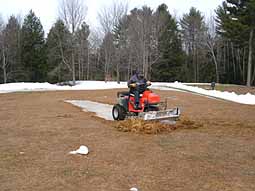Winter Damage: Location
April 15, 2009
Just another New England spring: Twenty degrees above normal one day, and twenty degrees below normal the next. The widely fluctuating temperatures create many challenges for superintendents who are attempting to nurse back annual bluegrass from a long, cold winter. Timing of applications for annual bluegrass seed heads and annual bluegrass weevil also is made tougher with the temperature swings. The Web site http://www.nrcc.cornell.edu/grass/degreedays/dd_weekly.html provides growing degree day information for the Northeast, and many Mid-Atlantic states to help with those management decisions.
Winter Damage
Reports have been coming in regarding annual bluegrass winter damage. Cold temperature and crown hydration injury has left its mark across many golf courses in the Berkshire Region, eastern New York, and more northern portions of New England and Canada. Reports indicate that the damage was not selective as both bentgrass and annual bluegrass have winter injury.
 |
|
| The extent of winter injury on golf courses in northern portions of New England and Canada is now being realized as warmer weather and the removal of covers exposes the playing surfaces. |
A "perfect storm" event in December may have been responsible for the severe damage; heavy rain turned snow into slush, which quickly turned to ice as temperatures rapidly fell far below freezing. In the past, severe weather events like this also have damaged the more tolerant bentgrass and Kentucky bluegrass. The ice at many golf courses remained in place under a good snow pack well into March. The encased plants were then subjected to anoxic conditions (low oxygen).
Sporadic winter injury has occurred elsewhere as well with more isolated reports of late winter and spring desiccation. Fortunately, at least some of the injury in the southern portions of the region appears to be more superficial as annual bluegrass is responding favorably to what little warm weather we have received.
Recovery Prognosis
Recovery for severely damaged golf courses will be a long and painful process that is dependent on the spring weather and a superintendent's ability to warm soil temperatures. Clear permeable covers can elevate soil temperatures on sunny days and help prevent heat loss at night. Working with covers is never easy, especially if damage is wide spread. The covers will have to be manipulated during warm, sunny days later in the spring to avoid over heating the seedling plants. They also will need to be replaced at night when freezing temperatures are predicted. Also, topdressing with black sand can elevate soil temperatures to speed seed germination and recovery.
Those who are working with damage exceeding fifty percent of the green's surface or where primary cupping areas are injured should utilize temporary greens if a full recovery is to be expected to occur by early to mid-summer. Not closing the greens is perhaps the biggest mistake we see and a primary reason for a failed recovery and very disgruntled golfers later in the season. The stigma with temporary greens is very real, but not nearly as bad as that associated with poor putting surfaces in July!
Severe winter injury is never easy to deal with, and superintendents and staff will be working very long and hard hours to recover the damaged areas and nurse the juvenile turf through the summer. The need for patience through the recovery process can not be emphasized enough! Golfers will hopefully understand that, in most cases, there is no immediate action that can be taken to prevent winter damage when the perfect weather conditions happen to occur.
Once again, this winter season proved that it's all about location when it comes to winter storms and cold temperature injury. Let us know how your golf course fared this winter and give us a call if we can help formulate a recovery strategy, develop a winter protection strategy, and provide additional support to work with the golfers.
Northeast Region Green Section- Dave Oatis, director
doatis@usga.org
; Adam Moeller, agronomist,
amoeller@usga.org
Jim Skorulski, senior agronomist,
jskorulski@usga.org
.
